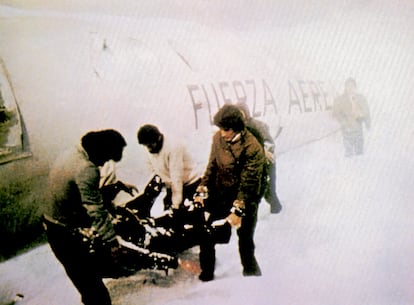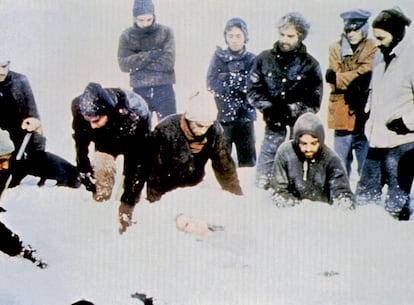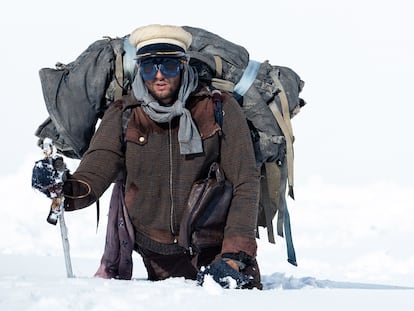‘A macabre piece of crap’: The Mexican film that narrated the tragedy of the Andes plane crash for the first time
Released in 1976, ‘Survive!’ was released well before the movies ‘Alive!’ and ‘Society of the Snow.’ The film was accused of exploiting and falsifying the events of the famous accident… although it has its defenders


The story of the Andes tragedy of 1972 — when a Uruguayan Air Force plane crashed in the mountain range — continues to have an impact 50 years later. Of the 45 people who were on board, 16 of them — presumed dead — managed to survive in extreme conditions for more than two months. Its latest movie adaptation — Society of the Snow — has been Netflix’s most-viewed film worldwide since it premiered on the platform this past January 4.
Based on the book of the same name by Pablo Vierci — published in 2008 — the film is Spain’s candidate for the Oscars. It has also offered a fresh look at the calamitous experience of the group of survivors — mainly made up of amateur rugby players and their friends and family — who resorted to eating the flesh of the corpses to save themselves. This detail caused enormous controversy at the time, with the Chilean newspaper El Mercurio publishing a photo of a half-eaten leg on the front page. Another — La Segunda — ran with the headline: “May God forgive them.”
“At the Last Supper, [Jesus] distributed his body and blood to all his apostles. There, he was making us understand that we should do the same. It was an intimate communion between all of us,” declared Pancho Delgado at the press conference offered by several of the survivors on December 28, 1972, just six days after the rescue. The news about cannibalism — which, according to the writer Piers Paul Read, author of the book Alive: The Story of the Andes Survivors (1974), was leaked by mountaineers who rescued them — dismantled the previously-circulated white lie that they had nourished themselves with herbs and cheese.

“The story of the survival of the young Uruguayans was sensational enough to interest all the newspapers in the entire world. But when the news spread that they had managed to survive by eating the bodies of the dead, those same media outlets seemed to become enraged,” he wrote. Read — who recorded the discomfort of the rescued — mentioned the suggestion made by an Argentine journalist that “the strongest had killed the weakest to feed themselves,” or the two pages of photographs of limbs and bones published by a magazine that “specialized in pornography.”
While the explanations satisfied public opinion and the family members of the deceased — in addition to receiving the tacit approval of the Church authorities — the morbidity was impactful. For this reason, in 1973 — before a single year had passed since the tragedy — Survive!, by Clay Blair, Jr., had already reached bookstores. A predictable bestseller, it summarized the events of the crash and the ordeal faced by the survivors. However, the following year, Read would release the official story, which was written with the collaboration and approval of those who left the Andes alive.
As soon as that first book was published, the movie adaptation was launched: Survive! It was a Mexican production directed by René Cardona, a key figure in the golden age of his country’s film industry, with close to 100 titles to his name, including thrillers, sports epics and musicals.
A May 1975 article in People magazine documented the climate of tension surrounding the filming, which took place at the Churubusco Azteca studios in Mexico City and at the top of the Popocatépetl volcano, to recreate the snowy Andean landscape. “I’m going to file a defamation suit against [Roberto] Canessa,” Cardona threatened, in the interview following the accusations of “piracy” that the survivor had levelled at the project. Journalists Renée Sallas and Eduardo Forte recounted how Cardona displayed the contract for the acquisition of the rights to Survive! during their meeting. “If there was piracy, it wasn’t done by us — it was done by the author.”

Cautiously, however, in the film, different names were given to the characters. Written and produced by Cardona’s son — one of the most prominent figures of exploitation and B-series cinema in Mexico — the 1976 film featured Hugo Stiglitz and received criticism for its attention to the more gruesome aspects of the tragedy. The scenes were quite graphic. At 114-minutes-long, half-an-hour was subtracted from the screening in the United States, where it was released (dubbed into English) in just 60 movie theaters. Still, it managed to exceed $1 million in revenue, or about $5.4 million in today’s money.
Eat or die
The trailer for Survive! already bluntly pointed to the crux of the issue. One of the men trying to track down the plane asks another, with great emotion: “If some of them survived, what are they going to eat?” Then, the shot jumps to a conversation in the Andes inside the fuselage of the plane. A survivor points out to his companions that “there are seven frozen corpses out there,” while a voice-over announces that the film addresses “a dramatic event of cannibalism that shook the world.”
With the staging and soundtrack of a horror film, in the moments after the accident, the director portrays one of the survivors putting a piece of intestine back into a corpse’s belly. This was a clear parallel to what happened with Enrique Platero, who survived the plane crash — after a metal bar got stuck in his abdomen — but died in an avalanche two weeks later.
The film — otherwise narrated very soberly and without frivolity — also shows images of corpses with their muscles exposed. It doesn’t keep too much distance from the horrors, while emphasizing the religious sphere, with the survivors evaluating the correctness of their actions. There are scatterings of biblical quotes, while one passenger holds a crucifix. These displays of religiosity are interspersed with each portion of meat that we see them cut from the dead bodies.
In one of the most intense sequences, the survivor who takes the initiative to resort to cannibalism is shown in a close-up, crying uncontrollably while he cuts open a dead body and tastes the first morsel.
Survive! was eventually relegated to oblivion, especially after the American version — Alive (1993) — was released. This adaptation adopted Piers Paul Read’s book and had Nando Parrado act as a technical advisor. He was the passenger who — together with Canessa — undertook the final 23-mile-long walk for 10 days that led to them being rescued. This film has been better-remembered over time.
Antonio Vizintín — alias Tintín, one of the survivors of the crash — wrote in a Facebook group that the Mexican film was “rubbish… it’s unfortunate that Mexico made such a macabre work [like this one].” Gustavo Zerbino — another of the survivors — described it as “very bad” in a 2023 interview with Mexico’s El Mundo. “At night, [in the film], they went out to pray the rosary around the plane at 40 degrees below zero,” he scoffed, lamenting the lack of vigor in achieving accuracy. Still, he added that the film — regardless of its reputation — did seem somewhat “respectful” to him.
“It’s evident that they wanted to exploit the morbidity… but I don’t think it is a sensationalist film. While there are crude scenes, it’s done with a surprising responsibility,” opines film critic and historian Antonio José Navarro, in an interview with EL PAÍS. He’s the author of The Infamous Banquet: Representations of Cannibalism in Cinema (2022). For Navarro, the Mexican version is — at the very least — substantially better than Alive, the 1993 film directed by Frank Marshall. “That was a Hollywood film where the central theme was omitted… everything became a story about adventure and self-improvement. But Survive! was made fresh, just four years after the catastrophe. Its approach seems correct to me. The film talks about how a group of religious, civilized people — who were studying at university and preparing to become doctors or lawyers — are pushed by circumstances to eat not anonymous dead people, but people they knew… friends and family. [The film] addresses the fundamental question: what process does a person with these characteristics go through when they have to [make a decision about] devouring their fellow man? And it’s done in a direct, honest and human way — it doesn’t paint them as monsters or degrade them.”

Although the critic has his reservations about Netflix’s Society of the Snow, he also believes that this latest version — by Spanish director Juan Antonio Bayona — is also a much superior version when compared to the American one. “He’s been more conscious than Marshall when it comes to addressing the issue. It’s very Bayona… he doesn’t want to be cruel or dwell on the sinister part. Although, there’s a creepy and very well-filmed scene, when — after being trapped by the avalanche (the one that occurred on the 17th day, which claimed eight victims) — one of the boys says ‘I think we’ll have to eat.’ He goes over to another of his recently-deceased companions and begins to chop him up. A terrible and [very powerful] moment,” he affirms.
“They were in a dilemma: to be victims of their moral and cultural prejudices, or survive. Throughout history, there have been situations — such as shipwrecks or sieges of cities due to war — where anthropophagy has been resorted to. But the fact that it was done in peacetime — and the cultural level of those involved — caused an impact. In Survive!, there was a point of exploitation if we’re referring to making use of a current topic… but many books did that too,” Navarro reasons. “The survivors themselves — with their explanations, or the books they’ve written — may also have had an exploitative interest… something that I don’t judge or condemn at all.”
With Society of the Snow, cinematic peace has been achieved for the survivors who remain alive. 14 out of 16 are still around today, although José Luis “Coche” Inciarte — who died in July 2023 — consulted on Bayona’s film and was also able to see a montage before he died. While filming the Netflix movie, there was close collaboration with the survivors, in the same way that the 2008 book — on which it is based — tried to encompass the entire experience of the group by giving a chapter to each one to tell their version. This adaptation is hence more transcendental, matured by the decades during which the protagonists have given lectures and have sought a deeper meaning — mostly religious — in their painful experiences.
Society of the Snow doesn’t have the urgency or direct interest in cannibalism as Survive!, but it offers a degree of precision and thoroughness in the recreation of the events. There’s an immersive focus on the day-by-day suffering of those who fought to stay alive in the mountain range.
Of course, the true horrors of reality appear to remain unattainable by fiction. “It’s a super light version of what happened on the mountain. It was much worse,” Canessa recently told Agence France-Presse. “If I made a movie about what it was really like, the audience would walk out of the theater.”
Sign up for our weekly newsletter to get more English-language news coverage from EL PAÍS USA Edition
Tu suscripción se está usando en otro dispositivo
¿Quieres añadir otro usuario a tu suscripción?
Si continúas leyendo en este dispositivo, no se podrá leer en el otro.
FlechaTu suscripción se está usando en otro dispositivo y solo puedes acceder a EL PAÍS desde un dispositivo a la vez.
Si quieres compartir tu cuenta, cambia tu suscripción a la modalidad Premium, así podrás añadir otro usuario. Cada uno accederá con su propia cuenta de email, lo que os permitirá personalizar vuestra experiencia en EL PAÍS.
¿Tienes una suscripción de empresa? Accede aquí para contratar más cuentas.
En el caso de no saber quién está usando tu cuenta, te recomendamos cambiar tu contraseña aquí.
Si decides continuar compartiendo tu cuenta, este mensaje se mostrará en tu dispositivo y en el de la otra persona que está usando tu cuenta de forma indefinida, afectando a tu experiencia de lectura. Puedes consultar aquí los términos y condiciones de la suscripción digital.
More information
Archived In
Últimas noticias
Welcome to the post-religion era: The idea of Christianity as the absolute truth has become obsolete
‘I thought you would like it’: The risky sexual practice popularized by TV shows and TikTok
The digitalization of tourism: ‘They promise experiences and gave us the worst possible one’
Mexican peso defies uncertainty with forecasts of a new period of stability in 2026
Most viewed
- Sinaloa Cartel war is taking its toll on Los Chapitos
- Oona Chaplin: ‘I told James Cameron that I was living in a treehouse and starting a permaculture project with a friend’
- Reinhard Genzel, Nobel laureate in physics: ‘One-minute videos will never give you the truth’
- Why the price of coffee has skyrocketed: from Brazilian plantations to specialty coffee houses
- Silver prices are going crazy: This is what’s fueling the rally










































